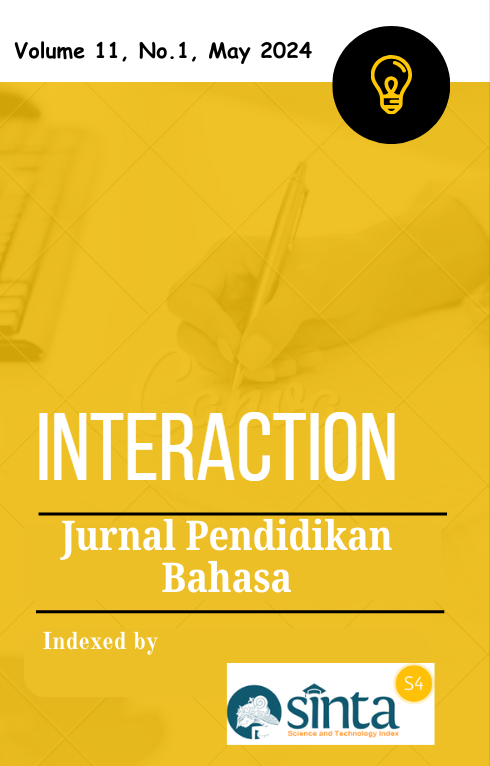Gender Inequality Analysis Represented in “Little Women” by Louisa May Alcott
Abstract
Gender inequality is the unequal allocation of opportunities and rights, among people of various genders. This commonly works against one gender, typically women. This research aims to analyze Louisa May Alcott's "Little Women" with a focus on gender inequality. A qualitative approach was used in this study. This study also used theory from Fakih (2008). The findings indicated that the novel describes five different forms of gender discrimination. The first is subordination, show that Jo cannot do anything she want because of her status as women. Second, stereotypes, when a woman behaves unfavorably or imitates a man, she will be perceived as a bad woman, like what Jo did because she always do the boyish tricks. Third, marginalization, show by Jo character that can be the backbone of his family when their father go to the war. Fourth, burden of work, where the Jo and also her sibling not only work to earn money, they also work at home to clean the house. For the last form, which is violence, it did not happen in the novel. In order to rouse women at the time, gender injustice was brought up in "Little Women," and as a result, the subject came to represent the state of American society at that time. The conversation and utterances of the characters make it clear that the female characters struggle to fit in with society.
Downloads
References
Abidin, A. Z., Ratnawati, D., Taufiqurrahim, T., & Aziz, T. (2020). Gender equality on Nahdlatul Ulama and Muhammadiyah perspective. PALASTREN Jurnal Studi Gender, 13(2), 383–412. https://doi.org/10.21043/palastren.v13i2.716
Adzkia, H. F., Soetisna, E. R., & Hermawati, Y. (2022). Gambaran ketidakadilan gender dalam novel Little Women: kajian kritik sastra feminis. Jurnal Educatio FKIP UNMA, 8(4), 1234–1245. https://doi.org/10.31949/educatio.v8i4.326.
Alcott, L. M. (1868). Little Women. Planet eBook.
Alcott, L. M. (2004). Little Women (C. Cautie & G. Stade, Eds.; Vol. 2). Barnes &
Noble, Inc.
Alfarini, D., & Tetty, M. (2022). Inequality act faced by the main character in novel Kim Ji Young, born 1982: a gender based study. TRANSFORM Journal of English Language Teaching and Learning, 11(4), 208–218. https://doi.org/10.24114/tj.v11i4.4403.
Alvira, F., Widisanti S, N. M., & Setyowati, A. (2021). Gender discrimination against women in Bina Shah’s Before She Sleeps:a review on the main character. Journal Albion : Journal of English Literature, Language, and Culture, 3(2), 55–59. https://doi.org/10.33751/albion.v3i2.453.
Aswar, L., & Juita, N. (2022). Representation of gender inequality in the novel Perempuan yang Menangis kepada Bulan Hitam by Dian Purnomo (critical discourse analysis). In Proceedings of the 5th International Conference on Language, Literature, and Education (ICLLE-5 2022) (pp. 68–76). Atlantis Press SARL. https://doi.org/10.2991/978-2-494069-85-5_9.
Ayu, B. (2019). The impact of gender inequality on women as reflected in George Gissing’s The Odd Women [Thesis]. Diponegoro University.
Damono, S. D. (2011). Pengarang, Karya Sastra Dan Pembaca. LiNGUA: Jurnal Ilmu Bahasa Dan Sastra, 1(1), 22–37. https://doi.org/10.18860/ling.v1i1.540
Ekasanti, N. R., & Hernawati, M. (2019). Representation of gender stereotyping in Louisa May Alcott’s Little Women: endorsement of traditional gender roles . Lexicon, 6(2), 111–118. https://doi.org/10.22146/lexicon.v6i2.54682
Fakih, M. (2008). Analisis gender & transformasi sosial. Insistpress.
Faradita, S. H., & Kusuma, D. L. (2021). The portrayal of gender inequality in well-behaved Indian women novel by Saumya Dave. Lililacs Journal : English Literature, Language, and Cultural Studies Journal, 1(2), 12–31. https://doi.org/10.21009/lililacs.012.02
Faradita, S. H., & Kusuma, D. L. (2022). The portrayal of gender inequality in well-behaved Indian women novel by Saumya Dave. Lililacs Journal : English Literature, Language, and Cultural Studies Journal, 1(2), 12–31. https://doi.org/10.21009/lililacs.012.02
Jacobsen, J. P. (2011). Gender inequality a key global challenge: reducing loses due to gender inequality.
Juhana, J., Qalbi, N., & Arfani, S. (2021). Gender inequality in the novel “Death of an Ex-Minister” by Nawal El Saadawi. Eralingua: Jurnal Pendidikan Bahasa Asing Dan Sastra, 5(1), 107–119. https://doi.org/10.26858/eralingua.v5i1.12543
Krismawati, M. (2021). Gender inequality reflected in Kate Chopin’s “The Awakening”: feminist approach [Thesis]. Putera Batam University.
Larasati, N. P. A. (2021). Gender inequality in Indonesia: facts and legal analysis. Law Research Review Quarterly, 7(4), 445455–445458. https://doi.org/10.15294/lrrq.v 7i4.48
Mardiyani, R., & Tawami, T. (2022a). Gender inequality and feminism in Arundhathy Roy’s The God of Small Things. MAHADAYA: Jurnal Bahasa, Sastra, Dan Budaya, 2(2), 165–174. https://doi.org/10.34010/mhd.v2i2.7598
Mardiyani, R., & Tawami, T. (2022b). Gender inequality and feminism in Arundhati Roy’s the God of Small Things. MAHADAYA: Jurnal Bahasa, Sastra, Dan Budaya, 2(2), 165–174. https://doi.org/10.34010/mhd.v2i2.7598
Maryam, L. H., Astuty, L. T., & Pradana, A. (2022). An analysis of gender inequality on black women characters in hidden figures film. Literary Criticism, 8(01), 44–50. https://jurnal.unived.ac.id/index.php/jlc/article/view/2761
Mayasari, R., Obaid, M., & Asni, A. (2020). Tarik menarik faktor-faktor sosial psikologis dalam terbentuknya sikap mahasiswa terhadap isu kesetaraan dan keadilan gender. PALASTREN: Jurnal Studi Gender, 13(2), 281–302. https://doi.org/10.21043/palastren.v13i2.653.
Merriam, S. B., & Tisdell, E. J. (2016). Qualitative research : a guide to design and implementation (4th ed.). John Wiley & Sons, Inc.
Mihira, L. S. N., Suwastini, N. K. A., Artini, N. N., Jayantini, I. G. A. S. R., Budiarta, I. W. (2021). Gender inequality represented in English textbooks: a literature review. Jurnal Ilmu Sosial Dan Humaniora, 10(3), 576–596. https://doi.org/10.23887/jish-undiksha.v10i3.39209
Muzaka, M., & Suyanto, S. (2020). The gender equality struggles in the novel if Perempuan Berkalung Sorban and Gadis Pantai. Poetika : Jurnal Ilmu Sastra, 8(2), 194–205. https://doi.org/10.22146/poetika.60528
Napsiah, N., Munthe, H. M., Ledyawati, L., & Wahjudin, L. (2023). Anak Mikhrul: exposing gender inequality in Lampung custom practices. PALASTREN: Jurnal Studi Gender, 16(1), 109–134. https://doi.org/10.21043/palastren.v16i1.14716
Nungrahenti, R. R. S. T. W. (2021). Women’s struggle against gender inequality reflected in Little Women novel: a feminist perspective [Thesis]. Muhammadiyah University
Nurgiyantoro, B. (2015). Teori pengkajian fiksi (11th ed.). Gadjah Mada University Press.
Prastyowati, S., Andini, T. M., & Prastiwi, W. (2019). The study of gender inequality found in Deborah Ellis’s novel “The Breadwinner” . Jurnal Perempuan Dan Anak, 2(2), 1–10. https://doi.org/10.22219/jpa.v2i2.9661
Putri, O., & Hariani, S. (2021). Woman’s bravery against gender inequality in Danielle Steel’s novel the Right Time. JOURNAL OF LANGUAGE, 3(1), 65–72. https://doi.org/10.30743/jol.v3i1.371
Ratna, N. K. (2015). Teori, metode, dan teknik penelitian sastra. Pustaka Pelajar.
S., N. (2020). The struggle of the main character against the inequality reflected in Little Women novel: feminist approach [Thesis]. Putera Batam University.
Santi, N. Y., & Rahmi, A. (2019). Feminism values in Louisa May Alcott’s Little Women. IMLAH: Islamic Manuscript of Linguistics and Humanity, 1(1), 49–66.https://ejournal.uinib.ac.id/jurnal/index.php/imlah/article/view/1216
Shang, B. (2022). Tackling gender inequality: definitions, trends, and policy designs (WP/22/232).Tong, R., & Botts, T. F. (2018). Feminist thought : a more comprehensive introduction. Westview Press.
Wurangian, M., Mamentu, A. C., & Andries, F. (2023). Gender inequality in Charlotte Bronte’s Jane Eyre. JoTELL: Journal of Teaching English, Linguistics, and Literature, 2(2), 155–172. https://doi.org/10.36582/jotell.v2i2.5757




.png)



22.png)
